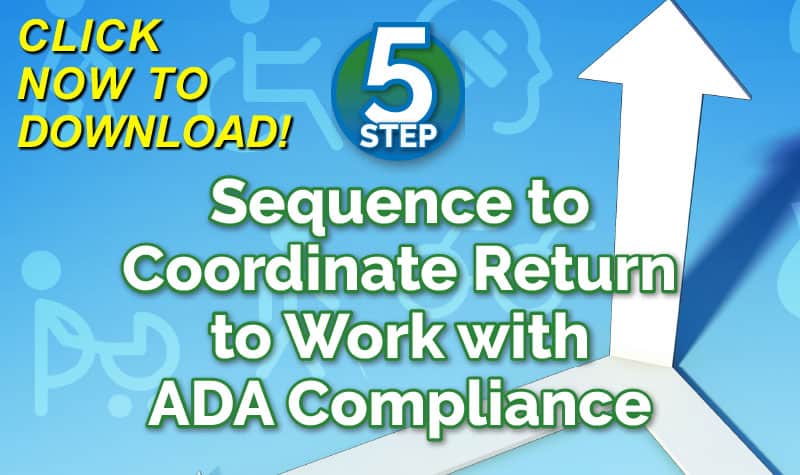Protecting the Bottom Line and Increasing Productivity with a Successful IDM Program
As the use of integrated disability management increases, best practices, or keys to program success, are emerging. A careful review of the following issues can help you decide whether an IDM program is an option worth pursuing for your organization.
1. Senior Management Support
Implementing an IDM program can be a resource-intensive initiative, and senior management should be firmly behind it before any making any commitments. An IDM program needs to be part of the overall corporate culture.
Click Link to Access Free PDF Download
“5-Step Sequence to Coordinate Return-to-Work with ADA Compliance”
2. Cross-Functional Team Approach
Integrated disability management requires interdepartmental cooperation and communication to be successful. Everyone must share the same goals and objectives in order for IDM to succeed! It is also important to designate an IDM program manager or advocate who will oversee the entire process.
3. Centralized Claim Reporting
A unified claim intake system for all disability claims (WC, short-term disability (STD), long-term disability (LTD) and Family and Medical Leave Act (FMLA), protects your company against potential duplicate claims, and it simplifies the reporting process for your employees.
4. Common Claim Management Protocols
Despite the differences in processing occupational and non-occupational disability claims, there should be common claim management guidelines such as:
a. 24 hour contact with employer
b. On-going contact with employee
c. Early intervention by nurse case manager or claim rep
d. Subrogation identification
e. Transitional work program
- Consistent Non-Occupational and Occupational Return-To-Work Programs
Bureau of Labor Statistics indicate if an employee is off work for six months due to occupational injury or illness, there is only a 50 percent chance the worker will ever return to work. If the employee is off for one year, there is less than a 25 percent chance of returning to work, and after two years, there is virtually no chance of ever returning to work, due to a phenomenon called “psychological dis-employment” – the worker becomes “used to” not working and “enjoys” being at home – possibly collecting work comp or disability payments for an extended period of time.
A primary objective of IDM is to return an injured or ill employee to work and productivity as quickly as possible. This requires a strong commitment from management to a “return-to-work” culture, with a formalized RTW programs and resources, for both non-occupational and occupational injuries and illnesses.
- Integrated Data Capture And Retrieval System
Integrated data allows you to benchmark and track the results of the IDM program. It also allows you to objectively report program results to senior management and your operating units, essential for their continued support and buy in. - Frequent, Clear Communications To Employees
Poor communication can be the undoing of an IDM program! Clearly communicating benefit policies and procedures will help avoid confusion among employees.
Author Rebecca Shafer, Consultant/Attorney, President, Amaxx Risks Solutions, Inc. has worked successfully for 20 years with many industries to reduce Workers’ Compensation costs, including airlines, healthcare, printing/publishing, pharmaceuticals, retail, hospitality and manufacturing. Contact: RShafer@ReduceYourWorkersComp.com.
WC Books: http://www.reduceyourworkerscomp.com/workers-comp-books-manuals.php
WC Calculator: http://www.reduceyourworkerscomp.com/calculator.php
Do not use this information without independent verification. All state laws vary. You should consult with your insurance broker or agent about workers’ comp issues.
©2010 Amaxx Risk Solutions, Inc. All rights reserved under International Copyright Law.







